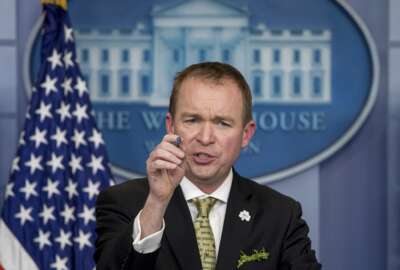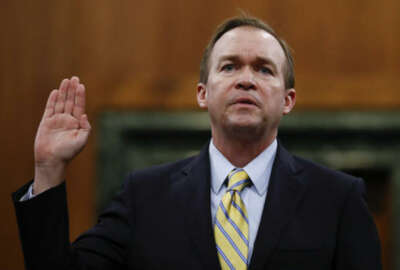
Federal overseers keeping close watch on how agencies engage employees through reorg
Officials from OPM and GAO say they are particularly interested in the thinking behind which skillsets agencies decide to keep through their reform plans.
With weeks to go before final reform plans are due to the Office of Management and Budget, workforce watchdogs are offering advice to agencies on how to preserve skillsets and promote personnel practices.
Mark Reinhold, the Office of Personnel Management’s associate director for employee service, and chief human capital officer, urged agencies to not only think about the employees who are walking out the door as a result of the reorganization, but also the people who are remaining with their agencies.
“Making sure that there are clear expectations for what their new roles might be, making sure that you’re attending to issues like skills and development to ensure that they’re equipped with the right kinds of skills to engage in what might be a changing role for them,” Reinhold said during the Aug. 9 Center for Organizational Excellence’s Agency Reform Summit in Washington. “All these are really at the end of the day important drivers of employee engagement. We want to engage in employees who are going to deliver on our mission.”
In June, agencies submitted their reform plans to OMB as part of the governmentwide reorganization plan directed by the Trump administration. Last month, OMB was set to meet with CFO Act agencies to offer feedback and point out areas where immediate action could be taken.
Final reform plans are due to OMB by September as part of the 2019 budget proposal, with the expectation that by February 2018, OMB will start tracking agency progress.
Within the reorganization memo, OMB also directed agencies to create a Manager Support Board comprised of internal experts on employee-labor relations to help managers agency-wide address performance and conduct issues.
For federal auditors, HR is critical when it comes to implementation of reform plans, said GAO’s Strategic Issues Director Robert Goldenkoff.
Similar to Reinhold’s advice, Goldenkoff said it’s important to “bring employees with you” through the reform and performance management process.
When you start talking about agency realignment, that has human capital implications, Goldenkoff said. For example, the realignment could mean a whole different skillset is required at an agency.
“One of the things that we’ll be looking at is … have they really thought through the human capital piece,” Goldenkoff said. “To the extent that agencies haven’t … I would certainly raise an eyebrow to the extent that has that really accomplished true reform; because if you have not really thought through the people you need to get this job done, to work in the transformed organization, it assumes that the people you have on board right now, and the composition and the skill mix, it doesn’t necessarily mean a smaller work force, although it could, but it would probably mean a very different workforce. And so if there are no changes there, and if agencies really haven’t thought that through, it just kind of assumes that the workforce you have today is going to be able to get you to where you need to be going forward, and that’s probably not going to be the case. That’s something that we’ll be looking at, how agencies look at their skillset and their skill mix going forward.”
Agencies won’t be on their own as they look through their existing skillsets and compare it to their future plans.
Reinhold said OPM has compiled “reams and reams” of guidance, tools and information on its website, to form a one-stop-shop for agencies as they think about their human capital management and reshaping their workforce.
“We’ve taken a hard look at how we at OPM can improve our ability to be responsive to agencies when they need help, or they have questions or they need technical assistance,” Reinhold said.
And for agencies requesting certain authorities, like approval for a early retirement, they’ve also streamlined that process down to a one-page template.
“Some of it is as simple as fill in the date range during which you want to offer the buyout,” Reinhold said. “This has not only been a great way to ease some of the burden on some of the agencies, but it’s also made OPM’s job easier, and hone in on exactly the information we need in order to evaluate the request.”
But agencies shouldn’t use a more streamlined system as an excuse to offer buyouts or early retirements for the sake of offering them.
“Workforce reshaping tools are really all about about how you get from where you are today to where you want to go,” Reinhold said. “I think there is this inclination among agencies to just say ‘oh my gosh, I just need to offer buyouts and early outs,’ which is fine and those are appropriate tools. What we often see is that agencies really haven’t invested in the thinking that needs to go behind making decisions about who you’re going to offer that to. Do you really want to offer it to every single employee in your agency or should you focus on surplus skillsets or obsolete skillsets. One of the things we look for in approving those requests is evidence that that kind of thinking has gone into it. Frankly, the last thing we want to do is enable an agency to do something that might ultimately result in a bad outcome for them, like we’ve now bought out all of the talent in this particular area, and we really, really need them so now we need a direct hiring authority to bring them back.”
Where innovation goes to die
Kristine Simmons, vice president of government affairs at the Partnership for Public Service, said one of the continuing challenges with the reorganization is trying to align what an administration values as performance, with what Congress views as performance and how it evaluates the performance of programs to make decisions on spending.
Reinhold said it’s important to understand the workforce planning that’s behind agencies’ strategic plans and annual performance plans.
“What we’ve seen with some of the agencies who do this really well, is that they manifest a lot of their human capital strategies very specifically in their congressional budget justifications, their strategic plans,” Reinhold said. “So it’s very clear to everyone kind of what the priorities are for ensuring that they have a workforce that’s going to be able to deliver on the mission priorities and strategies.”
Goldenkoff said from the oversight perspective, it’s also important for watchdogs to give agencies the opportunity to learn and grow as they implement their plans.
“I don’t think that oversight organizations really understand the process of innovation,” Goldenkoff said. “It’s basically you have innovation and you have oversight and they live in two very separate worlds and two very separate cultures. With innovation you fail early, fail often. That’s a good thing. Oversight, it has to work the first time out of the box. If it doesn’t, that’s where innovation can sometimes go to die, is in a good audit.”
Copyright © 2024 Federal News Network. All rights reserved. This website is not intended for users located within the European Economic Area.
Related Stories





